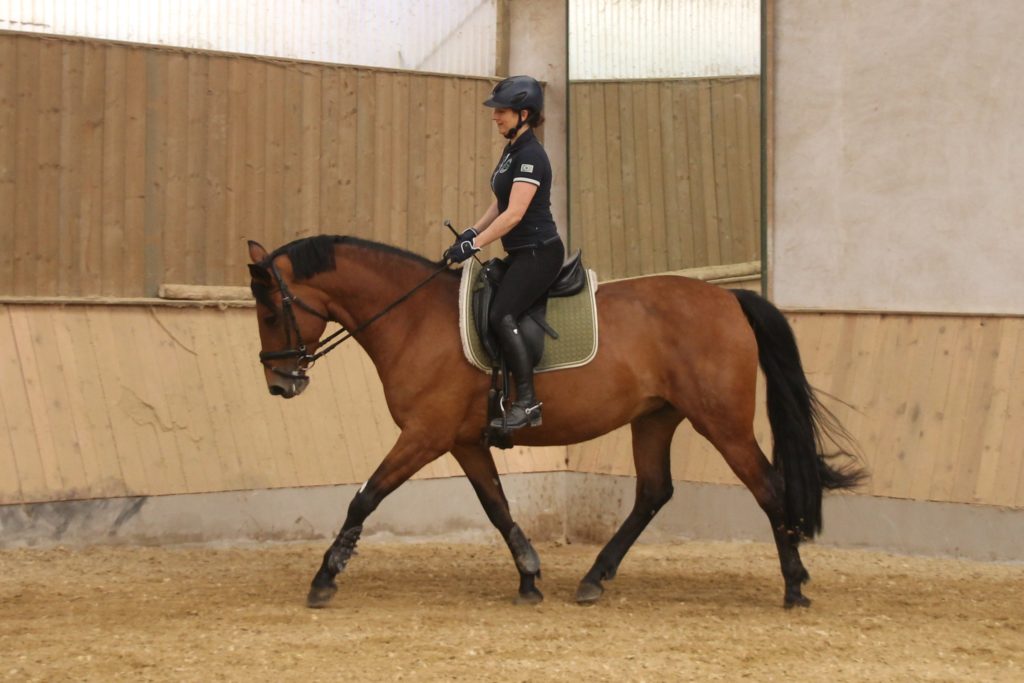Lolas 5th year started with many examinations and various treatment and training approaches. In the spring even more anomalies appeared. Our training was affected by diffuse lameness, which could often not be attributed to a particular leg and which could also change from one day to the next. Sometimes I also had the feeling that one leg just strides minimally shorter than the other. Very often those limits in the movement were only noticeable to the rider, not visible for others. As a rider you get a feeling that the moves are a little bit bumpy, not swinging through the whole body, a disconnect or synchronicity issue between forehand and hind legs. Also Lola started dragging her hindlegs on the ground which was back then visible on the hooves.
- Shifting lameness
- Synchronicity issues between forehand and hind legs
- Dragging hindlegs
All those factors somehow reduced the effect of half halts, the willingness for collection was no longer present. One more very concerning issue came up when Lola started to relax during training: her stifles became really unstable and sometimes they just gave in underneath her causing her to stumble badly, very often in the corners. So far we observed this mainly in the trot, it seems to be really painful for her but also seems risky for the rider as the horse might fall down. This was a common issue in phases of rehabilitation.
- Half halts have no effect (no preparedness to collect)
- Stifle issues
Seeing all those developments and unsuccessful therapies, we drove Lola to the equine clinic in Tillysburg upon recommendation of our vet to check her through thouroughly from head to toe. Even back then the vets believed it was a muscle problem but they thought it came from an injury. They sent us home with a very specific training programme to be executed over a few months.
Over time, lungeing became more and more difficult, Lola found it hard to move on a circle and not lose her balance. Or at least that is what it looks like – she feels she loses her balance and tries to compensate by running faster and faster. For this she tilts over the inside shoulder and holds head and neck to the outside so that she does not fall over. If she happens to hear any sound she feels is suitable for spooking (like another horse walking outside of the indoor arena) she goes off like a rocket in insanely fast gallop and maximum tilt, regularly destroying herself, tearing the equipment, losing the lunger and leaving craters in the arena floor. She was not like that when we started her so this was new behaviour. Unfortunately in one of those episodes she severely damaged her suspensory ligament (left hindleg) and we were off to the clinic again. The resulting break (box rest with only walking or treadmill) and slow, careful rehabilitation were really challenging for Lola (and not only for her), she became really explosive and difficult to handle (bucking, rearing, kicking).
- Challenges when lungeing
- Explosive behaviour
During summer 2016 we made some positive progress, at least we could get back to training with some regularity. But Autumn was nearly an exact copy of last year, only the other suspensory ligament (right hindleg) was torn after running around like crazy (being lunged). Again rest in combination with treadmill and a slow comeback in spring 2017. In the summer 2017 we saw some real improvements in the Training, especially in canter work but in autumn again her condition deteriorated. But this time it was not unexpected at least.
- Seasonal ups and downs (Summer always better, time of fur change to summer or to winter is always worst)
That winter we survived without major injuries, maybe because we stopped lungeing for good. But then next summer came as a surprise, Lola was so tight, not willing to move forward, i had to drag her out of the stable into the field but when ridden she was extremely explosive. When I collected her from the field and we walked down that small hill, she was nearly unable to lift her hindlegs enough to properly walk downwards and placing the hooves under the balance point.
- Dragging hooves when walking down, sometimes they give way completely
- Throwing her head when cantering
Then she started again showing reluctance to move forward when ridden and showing undefined lameness in autumn 2018, we took her once more to the horse clinic in Tillysburg where we spent a whole day with different examinations. She was clearly lame presented at hand and ridden there but still there was no diagnosis but only a series of further tests and examinations. After consulting our vet again she suggested we should test for all hereditary diseases that could be tested which we did. The well known standard tests for quarter horses showed no result (Hypp, PSSM1,…) but reading about other peoples and horses stories and also watching videos we felt that our issues looked much the same and so we were not surprised at all that the result of the hair strand genetic* test for PSSM2 (which was very new back then) showed a positive result (n/P2, n/Px). At least it had a name after such a long time searching… and we are not alone with this.
*Also we are following the discussions about the validity of the genetic analysis compared to a muscle biopsy. We went for the pain free version of the test in alignment with our vets recommendation.

Dressage training 

Warming and relaxing muscles 
Enthusiastic on the treadmill 
Treadmill 
Treadmill